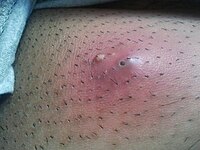
Photo from wikipedia
Purpose To compare the treatment efficacy of percutaneous catheter drainage alone to catheter drainage combined with ozone in the management of pyogenic liver abscess (PLA). Material and methods This prospective… Click to show full abstract
Purpose To compare the treatment efficacy of percutaneous catheter drainage alone to catheter drainage combined with ozone in the management of pyogenic liver abscess (PLA). Material and methods This prospective study included 85 patients diagnosed with PLA. All patients were randomly divided into two groups: catheter drainage alone (Group I); catheter drainage combined with ozone (Group II). Drainage was considered successful when: 1) the abscess cavities were completely drained, and 2) clinical symptoms were resolved. Kruskall-Wallis nonparametric test was used to compare the success rates, length of stay (LOS), and need of further surgery. A value of p < 0.05 was considered significant for all statistical analyses. Results In all the patients’ percutaneous catheters were placed successfully under the guidance of computed tomography. All of the patients in Group I (43; 50.6%) were treated with percutaneous catheter drainage alone, while the patients in Group II (42; 49.4%) were treated with PCD combined with ozone. The success rates of Group I and II were 81% and 94%, respectively (p < 0.05). The duration of fever as well as LOS was longer for Group I when compared with Group II (p < 0.05). Conclusions Catheter drainage combined with ozone is an effective and safe treatment in PLA.
Journal Title: Polish Journal of Radiology
Year Published: 2018
Link to full text (if available)
Share on Social Media: Sign Up to like & get
recommendations!